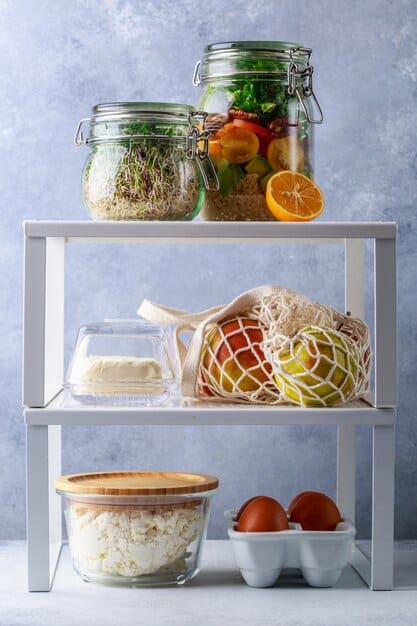Save Money on Groceries: Cut Your Food Bill by 25%

Navigating the complexities of grocery shopping while striving for significant savings requires a strategic approach, encompassing everything from mindful meal planning to leveraging digital tools, ultimately enabling consumers to reduce their food bill by as much as 25% through consistent, informed decisions that prioritize value without compromising nutrition.
In an era where every penny counts, mastering the art of saving money on groceries can significantly impact your household budget. This comprehensive guide will equip you with practical strategies and expert insights on How to Save Money on Groceries: A Comprehensive Guide to Reducing Your Food Bill by 25%, transforming your shopping habits and helping you achieve tangible financial improvements.
Strategic Meal Planning: The Foundation of Savings
Effective meal planning is not merely about deciding what to eat; it’s a powerful financial tool that dramatically reduces food waste and impulsive purchases. By taking a few moments each week to outline your meals, you gain control over your grocery list and, consequently, your spending.
This organized approach ensures that every item you purchase has a purpose, preventing those expensive, forgotten ingredients that end up in the trash. It’s a habit that pays dividends, both in financial savings and reduced stress.
Assessing Current Habits and Needs
Before you dive into planning, it’s crucial to understand your household’s eating habits and dietary needs. This involves a candid assessment of what you typically eat, how often you dine out, and any specific dietary restrictions or preferences.
- Track Food Waste: For one week, note down all unused food that expires or goes bad. This highlights areas for improvement.
- Analyze Takeout/Dine-Out Trends: Understand how often you’re eating out and what triggers these decisions.
- Evaluate Pantry Staples: Check what you already have to avoid buying duplicates.
Once you have a clear picture, you can start building a realistic meal plan that aligns with your lifestyle, minimizing the chances of reverting to old, costly habits. This personalized approach makes the savings sustainable.
Crafting a Weekly Meal Plan
Designing your weekly meal plan doesn’t have to be rigid or tedious. Think of it as a creative exercise where you combine various dishes to utilize ingredients efficiently. Focus on versatility, using common ingredients across multiple meals.
Consider dedicating specific days to certain types of meals, such as “Meatless Monday” or “Pasta Tuesday.” This structure can simplify your process while introducing variety. Leftovers are your friend; plan for them to become next day’s lunch, maximizing every meal’s value.
The goal is to create a dynamic plan that’s flexible enough to adapt to unexpected changes but structured enough to guide your shopping list. This proactive approach curbs last-minute, expensive food decisions.
By investing time in strategic meal planning, you lay a solid foundation for significant grocery savings, ensuring that every dollar spent on food is utilized to its fullest potential.
Mastering the Art of Grocery Shopping: Smart Strategies
Grocery shopping can often feel like a battlefield between your budget and your desires. However, with a few refined strategies, you can transform it into a highly efficient and cost-effective mission. It’s about being prepared, resisting impulse buys, and making informed choices at every turn.
Your shopping trip begins long before you step into the store. This preparation is key to avoiding common pitfalls that lead to overspending and food waste. Each item in your cart should be a deliberate decision, not a whim.

Creating an Optimized Shopping List
Your shopping list is your most powerful weapon against overspending. Don’t just list items; optimize it for savings. Categorize items by store section (produce, dairy, pantry) to minimize zig-zagging and temptation.
- Check for Sales & Coupons: Before writing your list, scan weekly circulars and digital coupons from your preferred stores.
- Prioritize Needs vs. Wants: Distinguish between essential items and discretionary purchases.
- List Specific Quantities: Knowing exactly how much you need prevents over-buying.
Stick to your list rigorously. Every deviation is a potential budget breach. An optimized list ensures you buy exactly what you need, reducing both expenditure and food waste significantly.
Shopping In-Store with Purpose
Once you are in the grocery store, every decision matters. Avoid shopping when hungry, as this often leads to impulse buys of less healthy, more expensive items. Pay attention to unit pricing – this is how you truly compare costs between different brands and sizes.
Look for store brand alternatives, which often offer comparable quality at a lower price. Don’t be swayed by prominent product placements; common sense indicates these are often higher-margin items for the store.
Consider shopping the perimeter of the store first, where fresh produce, dairy, and meats are typically located. The center aisles often house processed foods, which tend to be more expensive and less essential. By shopping with intention, you navigate the store efficiently and prevent budget creep.
Mastering these in-store strategies turns a routine chore into an exercise in fiscal responsibility, directly contributing to substantial savings on your food bill. It requires discipline, but the benefits are clear.
Leveraging Digital Tools and Community Resources
In the modern age, technology offers a wealth of opportunities to save money on groceries. From apps that track prices to online communities sharing deals, digital tools can automate and enhance your savings efforts. These resources provide insights and opportunities that simply weren’t available in the past.
Beyond digital, local community resources, such as food cooperatives and farmers’ markets, offer fresh, often more affordable alternatives to large supermarkets. Combining these approaches creates a robust savings strategy.
Utilizing Grocery Apps and Websites
Numerous apps and websites are specifically designed to help you save money. These tools can compare prices across different retailers, provide digital coupons, and even offer cashback rewards.
- Price Comparison Apps: Use apps like Flipp or Basket to compare prices on your shopping list across local stores.
- Digital Coupons and Loyalty Programs: Sign up for store loyalty programs and download their apps for exclusive digital coupons.
- Cashback and Rebate Apps: Apps like Ibotta or Checkout 51 offer rebates on specific purchases after you upload your receipt.
These apps can identify the cheapest place to buy each item on your list, allowing you to optimize your shopping trips or decide where to do your entire shop for maximum savings. Integrating them into your routine makes saving effortless.
Exploring Farmers’ Markets and Food Co-ops
While supermarkets offer convenience, farmers’ markets and food co-ops can provide significant savings, especially on fresh, seasonal produce. Buying directly from producers often means lower prices due to fewer intermediaries.
Farmers’ markets are excellent places to find seasonal fruits and vegetables at their peak freshness and lowest prices. Many vendors are willing to negotiate, especially towards closing time.
Food co-operatives, on the other hand, often require a membership but offer bulk buying opportunities and access to specialty items at wholesale prices. These environments foster a sense of community and promote sustainable food systems.
Engaging with these resources not only saves money but also potentially offers higher quality, fresher ingredients while supporting local economies. It’s a win-win for your wallet and your community.
By smartly integrating digital tools and local resources into your grocery routine, you build a multi-faceted approach to saving, pushing you closer to that 25% reduction in your food bill.
Smart Stockpiling and Pantry Management
A well-managed pantry is a hidden goldmine for grocery savings. Strategic stockpiling of non-perishable goods during sales, combined with conscious pantry rotation, dramatically reduces the need to pay full price for staples. It’s about proactive planning rather than reactive buying.
This approach transforms your pantry from a mere storage space into an active component of your budget-saving strategy. It ensures you always have essential ingredients on hand, minimizing last-minute, expensive grocery runs.
Buying in Bulk Wisely
Buying in bulk can lead to significant savings, but only when done intelligently. Not all bulk purchases are created equal. Focus on items you use frequently and those with a long shelf life, such as grains, canned goods, and frozen vegetables.
- Calculate Unit Price: Always compare the price per unit (ounce, pound, count) to ensure bulk is truly cheaper.
- Consider Storage Space: Don’t buy more than you can realistically store without spoilage.
- Avoid Perishable Overstocking: Large quantities of perishable items often lead to waste unless you have a plan for them.
Membership warehouses like Costco or Sam’s Club can be beneficial for bulk purchases, but factor in the membership fee. For smaller households, splitting bulk purchases with friends or family might be a more practical solution. Wise bulk buying is about efficiency, not just quantity.
FIFO: First-In, First-Out for Pantry Organization
The “First-In, First-Out” (FIFO) method is crucial for managing your pantry and freezer efficiently. It means using older items before newer ones, preventing food from expiring and going to waste.
Organize your pantry so that items with earlier expiration dates are at the front, visible and easily accessible. When you bring new groceries home, move existing items forward and place new ones behind them. This simple system ensures a constant rotation.
Regularly auditing your pantry helps you understand what you have and what you need, preventing unnecessary purchases. It also encourages creativity in meal planning, prompting you to use up ingredients before they spoil. An organized pantry is a lean, budget-friendly pantry.
By mastering smart stockpiling and meticulous pantry management, you transform your home storage into a powerful tool for reducing your grocery expenditure, ensuring every item bought serves its purpose.
Minimizing Food Waste: Every Scraps Counts
Food waste is not just an environmental issue; it’s a significant financial drain. Every item that ends up in the bin represents money unnecessarily spent. By adopting practices that minimize food waste, you directly contribute to reducing your grocery bill and maximizing your culinary resources.
This shift in mindset from consumer to resourceful innovator can unlock surprising savings. It’s about valuing every ingredient and rethinking what’s considered “waste.”
Creative Use of Leftovers and Scraps
Transforming leftovers and typically discarded scraps into new meals is a cornerstone of a zero-waste kitchen. It requires a bit of creativity but yields immense financial and culinary rewards.
- Repurpose Leftovers: Turn last night’s roasted chicken into tomorrow’s sandwiches or soup.
- Utilize Vegetable Scraps: Keep vegetable trimmings (carrot peels, onion skins, celery ends) for homemade stock.
- Freeze Excess Herbs: Chop and freeze herbs in olive oil or water in ice cube trays for future use.
Even fruit peels can be used for zests, infused waters, or compost. By viewing every part of an ingredient as potentially useful, you reduce your reliance on buying new items and cut down on waste. This thinking extends the life of your food budget.
Proper Food Storage Practices
The way you store your food significantly impacts its shelf life and freshness. Incorrect storage is a major cause of premature spoilage, leading to unnecessary waste and repurchases.

Understand the optimal storage conditions for different types of food: some vegetables prefer cool, dry places, while others thrive in the refrigerator. Use airtight containers to prolong freshness and prevent freezer burn.
Regularly check expiration dates and use the FIFO method mentioned earlier. Don’t rely solely on “best by” dates; learn to identify signs of spoilage. Educating yourself on proper food storage is an essential skill for any budget-conscious household.
By implementing these practices, you ensure that your produce, dairy, and pantry items remain fresh for longer, reducing the frequency of grocery runs and directly contributing to your savings goals. Every piece of food eaten instead of discarded is money saved.
Minimizing food waste isn’t just a trend; it’s a fundamental principle of financial prudence and sustainable living, pivotal in achieving a 25% reduction in your food bill.
Smart Shopping Alternatives and Dietary Shifts
Beyond traditional grocery stores, a world of alternative shopping venues and slight dietary adjustments can significantly impact your food budget. Exploring these options and making conscious choices about what you consume can unlock substantial savings, contributing directly to your 25% reduction goal.
It’s about expanding your horizons beyond the conventional supermarket and being open to subtle changes in your eating habits that align with both health and financial goals.
Exploring Discount Grocers and Asian Markets
While mainstream supermarkets are convenient, discount grocers and international markets, particularly Asian markets, often offer surprisingly low prices on a wide array of items. These stores specialize in volume and often have different supply chains.
- Discount Grocers (e.g., Aldi, Lidl): Known for their no-frills approach, offering significantly lower prices on private-label brands and select national brands. Quality is often comparable to major chains.
- Asian Markets: Excellent for fresh produce, spices, rice, noodles, and unique ingredients at competitive prices. Buying staples like rice and sauces here can be vastly cheaper than at regular supermarkets.
- Ethnic Markets: Explore other ethnic markets (e.g., Middle Eastern, Latin American) for bulk spices, legumes, and specialty produce often at lower costs.
Making a trip to these specialized stores, perhaps once a month for staples, can yield considerable savings. The key is to know what items are truly cheaper and to prioritize those in your purchases.
Reducing Meat Consumption and Embracing Plant-Based Meals
Meat and animal products are often the most expensive components of a grocery bill. Shifting towards more plant-based meals, even just a few times a week, can lead to substantial savings without compromising nutrition.
Legumes (beans, lentils, chickpeas), whole grains, and a variety of vegetables are not only typically cheaper than meat but also pack a powerful nutritional punch. They are filling, versatile, and excellent sources of protein and fiber.
Explore recipes that feature these ingredients prominently. Many traditional cuisines worldwide are naturally plant-forward and budget-friendly. This isn’t about becoming vegetarian or vegan, but about incorporating more affordable and healthy plant-based options into your diet.
This dietary shift also often leads to health benefits and a reduced environmental footprint, making it a win-win strategy. By thoughtfully integrating these alternatives, your path to a 25% lower food bill becomes clearer and more sustainable.
Embracing these smart shopping alternatives and flexible dietary considerations offers novel avenues for saving, making your journey to a reduced grocery bill both efficient and enjoyable.
Long-Term Savings Habits and Mindset Shift
Achieving a 25% reduction in your grocery bill isn’t a one-time event; it’s a culmination of consistent, disciplined habits and a fundamental mindset shift towards value and resourcefulness. Sustainable savings come from integrating these practices into your daily life, transforming them from tasks into second nature.
This final section emphasizes the importance of commitment and continuous learning, ensuring that the savings you achieve today become the norm for tomorrow.
Budgeting for Groceries and Tracking Expenses
A crucial component of long-term savings is actively budgeting for groceries and tracking your expenditures. This gives you clear visibility into where your money is going and identifies areas for improvement.
- Set a Realistic Budget: Based on your current spending and savings goals, allocate a specific amount for groceries each month.
- Track Every Expense: Use a budgeting app, spreadsheet, or simple notebook to log all grocery purchases.
- Review and Adjust: At the end of each month, review your spending against your budget. Identify successes and areas where you overspent, and adjust your strategy for the next month.
This ongoing feedback loop is invaluable. It helps you stay accountable, refine your strategies, and celebrate your progress. Without tracking, it’s difficult to know if your efforts are truly paying off.
Cultivating a Frugal and Resourceful Mindset
Ultimately, sustainable grocery savings come from within. Cultivating a mindset that values frugality, resourcefulness, and mindful consumption is perhaps the most powerful tool you possess.
Challenge yourself to be creative with what you have before buying more. Embrace the satisfaction of making something delicious out of simple, affordable ingredients. See food waste as wasted money, and take pride in minimizing it.
This mindset extends beyond the grocery store; it influences how you handle all aspects of your finances. It’s about becoming a savvy consumer, always seeking value, and making intentional choices that support your financial well-being.
By consistently applying the strategies outlined in this guide and nurturing a frugal mindset, reducing your food bill by 25% becomes not just a possibility, but a sustainable reality, paving the way for greater financial freedom.
Embrace the journey of becoming a smarter grocery shopper, and watch your savings grow.
| Key Strategy | Brief Description |
|---|---|
| 🛒 Smart Planning | Plan meals weekly, create optimized lists, and check sales before shopping. |
| 📱 Digital Tools | Utilize apps for price comparison, digital coupons, and cashback offers. |
| ♻️ Reduce Waste | Repurpose leftovers, use food scraps, and practice proper food storage (FIFO). |
| 💰 Budget & Mindset | Set a grocery budget, track expenses, and cultivate a frugal, resourceful approach. |
Frequently Asked Questions About Saving on Groceries
▼
The most effective first step is strategic meal planning. By outlining exactly what you’ll eat for the week, you can create a precise shopping list, minimizing impulsive buys and ensuring every ingredient purchased serves a purpose, directly curbing overspending.
▼
Digital tools like price comparison apps (e.g., Flipp), digital coupon platforms, and cashback apps (e.g., Ibotta) offer significant savings. They help you find the best deals, access exclusive discounts, and even get money back on purchases, automating the saving process.
▼
Buying in bulk can save money, but it’s not always the best option. It’s most effective for non-perishable items you use frequently, provided you have adequate storage. Always check the unit price and avoid over-buying perishables that might spoil before consumption.
▼
Quick ways to reduce food waste include proper food storage (e.g., airtight containers, understanding ideal temperatures), practicing “First-In, First-Out” (FIFO) in your pantry, creatively using leftovers, and freezing excess produce before it spoils. Each action saves money.
▼
Yes, significantly. Meat and animal products are typically among the most expensive items in a grocery cart. Substituting even a few meat-based meals with plant-based alternatives like legumes, grains, and vegetables can lead to substantial savings over time, contributing to your overall reduction goal.
Conclusion
Achieving a 25% reduction in your grocery bill is an ambitious yet entirely attainable goal that reaps profound financial benefits. It requires a blend of strategic planning before you shop, mindful decisions while in the store, and a resourceful approach to food management at home. By embracing practices such as rigorous meal planning, leveraging digital tools for deals, strategically buying in bulk, meticulously minimizing food waste, and exploring alternative shopping venues, you empower yourself to take control of your food expenses. Cultivating a frugal mindset transforms these individual strategies into sustainable habits, ensuring long-term financial health. The journey to a lower food bill is not just about cutting costs; it’s about fostering efficiency, creativity, and a deeper appreciation for the food you consume, leading to a healthier wallet and a more sustainable lifestyle.





